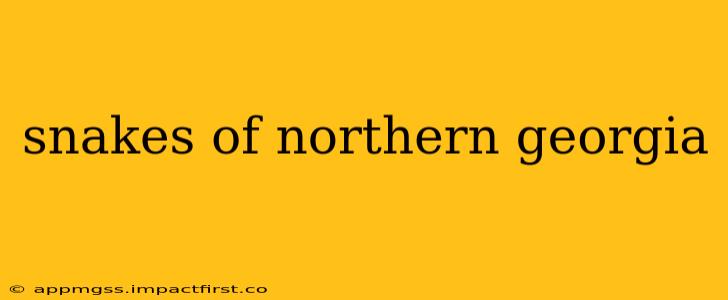Northern Georgia boasts a diverse range of snake species, from the harmless garter snake to the venomous copperhead. Understanding these snakes is crucial for safety and appreciating the region's biodiversity. This guide explores the common snakes found in Northern Georgia, addressing safety concerns and dispelling common myths.
What types of snakes live in Northern Georgia?
Northern Georgia's varied habitats—from forests and mountains to wetlands and urban areas—support a diverse snake population. Some of the most commonly encountered snakes include:
- Eastern Garter Snake (Thamnophis sirtalis sirtalis): A non-venomous, slender snake with three distinct stripes running down its back. They're often found near water sources and are relatively docile.
- Black Racer (Coluber constrictor): Another non-venomous species, the black racer is known for its speed and agility. They are typically dark brown or black and are often mistaken for venomous snakes due to their size and swift movements.
- Corn Snake (Pantherophis guttatus): A non-venomous, attractive snake with a variety of color patterns. Often kept as pets, they can sometimes be found in the wild.
- Copperhead (Agkistrodon contortrix): A venomous pit viper with a distinctive copper-colored head. They are ambush predators and their bite can be medically significant, requiring immediate medical attention.
- Timber Rattlesnake (Crotalus horridus): A large, venomous pit viper with a distinctive rattle at the end of its tail. These snakes are relatively uncommon but pose a serious threat if encountered.
- Cottonmouth (Agkistrodon piscivorus): Also known as a water moccasin, this venomous pit viper is found near water sources. They possess a characteristic dark-colored mouth.
Are there venomous snakes in Northern Georgia?
Yes, Northern Georgia is home to several venomous snake species, most notably the copperhead, timber rattlesnake, and cottonmouth. It's crucial to understand how to identify these snakes and how to react if you encounter one.
How can I identify venomous snakes in Northern Georgia?
While there are variations within each species, several characteristics can help distinguish venomous snakes:
- Triangular Head: Venomous snakes often have a triangular-shaped head, wider than their neck.
- Heat-Sensing Pits: Pit vipers (copperheads, cottonmouths, and rattlesnakes) have heat-sensing pits between their eyes and nostrils.
- Rattles (Rattlesnakes): The presence of a rattle is a definitive sign of a rattlesnake.
- Vertical Pupils (Most Venomous): Venomous snakes generally possess elliptical or vertical pupils, unlike the round pupils of most non-venomous snakes.
Important Note: Do not rely solely on these visual cues for identification. If you are unsure whether a snake is venomous, treat it as venomous and avoid contact.
What should I do if I see a snake in Northern Georgia?
The best course of action when encountering a snake is to leave it alone. Observe it from a safe distance and allow it to move on its own. Do not attempt to handle or kill the snake. Most snakebites occur when people try to handle or kill a snake.
What should I do if I am bitten by a snake in Northern Georgia?
If bitten by a snake, remain calm. Seek immediate medical attention. Note the snake's appearance (if possible, but do not put yourself at risk to do so) and try to remember as many details as possible to aid medical professionals in determining the appropriate antivenom.
Are all snakes in Northern Georgia dangerous?
No, the vast majority of snakes in Northern Georgia are harmless. Many play a vital role in the ecosystem by controlling rodent populations. Unprovoked attacks are rare.
What is the best way to prevent snake bites in Northern Georgia?
Preventing snake bites involves practicing caution and awareness:
- Wear appropriate footwear: When hiking or walking in areas where snakes are likely to be present, wear sturdy boots and long pants.
- Be cautious at night: Many snakes are nocturnal. Avoid walking in tall grass or brush at night.
- Keep your yard clean: Remove debris, rocks, and wood piles that can provide shelter for snakes.
- Use caution near water sources: Snakes often congregate near water sources.
- Never try to handle a snake: Admire them from a distance and leave them alone.
This guide provides a general overview of snakes found in Northern Georgia. For more specific information or if you suspect a venomous snake bite, contact your local health department or wildlife agency. Remember, responsible coexistence with wildlife is key to enjoying the natural beauty of Northern Georgia.
